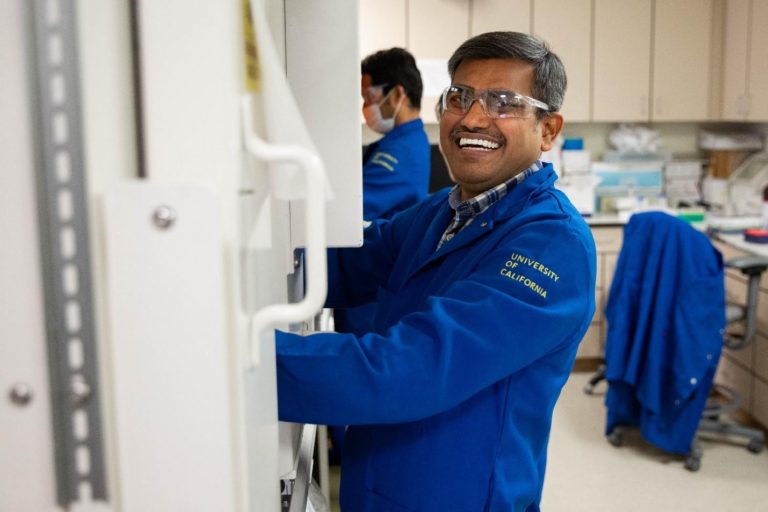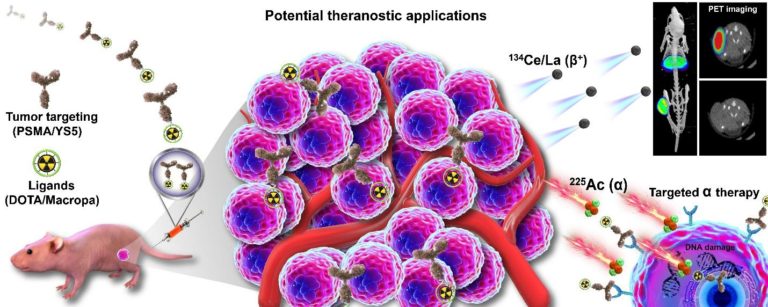A Theranostic Duo: Cerium and Lanthanum for Enhanced Alpha Radiotherapy
Work done in the lab of Prof. Robert Flavell at Department of Radiology and Biomedical Imaging, University of California San Francisco.
Dr. Kondapa Naidu Bobba is a trained medicinal chemist with nearly ten years of extensive research experience in synthetic organic chemistry in numerous medicinal chemistry industries in India and a Ph.D. in chemical biology. His current research focuses primarily on the development of radio-theranostics for the treatment of malignancies. His research in radio-theranostics emphasizes the development of prostate cancer diagnostic and therapeutic agents. Aim to provide personalized treatment options and enable clinicians to monitor the efficacy of therapy in real-time by combining imaging and therapy into a single approach. He is devoted to advancing radiopharmaceuticals, contributing to scientific literature, and translating research findings into clinical practice. He has published numerous research articles in prestigious scientific journals and presented his findings at national and international conferences. Dr. Bobba is a dedicated and accomplished researcher with a passion for scientific inquiry and a dedication to advancing the radiopharmaceutical field in cancer.

Author Interview
How would you explain your research outcomes to the non-scientific community?
Our research study aimed to develop an Imaging surrogate for Actinium-225 α-radiotherapeutics. Targeted alpha radiotherapy using Actinium-225 is a promising approach for treating metastatic cancers, including prostate cancer. It is essential to perform molecular imaging studies to detect the tumor’s radiotherapy agent localization and plan treatment. However, this is not possible with 225Ac labeled agents. The in vivo generator 134Ce/134La has been proposed as a potential PET imaging surrogate for 225Ac.
The significance of our findings is that by using the theranostic pair -Cerium/Lanthanum-134 (134Ce/La), we can visualize the biodistribution and dosimetry of the therapeutic agent and monitor the treatment response in real-time. This imaging capability allows doctors to precisely determine the location and dosimetry of the therapeutic agent within the patient’s body. It can improve the accuracy and efficacy of alpha-radiotherapeutics, leading to better outcomes for patients with cancer or other diseases that can be treated using targeted alpha therapy.

“Our research outcomes contribute to advancing theranostics, treatment monitoring, precision medicine, future medical imaging, and targeted alpha therapy research.”
How do these findings contribute to your research area?
Theranostics is an emerging field combining imaging and therapy, allowing a personalized approach to treating cancer and other diseases. However, targeted alpha radiotherapy shows great promise for various cancers, including prostate cancer. Unfortunately, localization and accurate dose estimation are a considerable challenge due to the need for imaging isotopes with similar half-lives and chemistry to actinium-225. We developed a PET Imaging surrogate using 134Ce/La pair to overcome these challenges. A robust 134Ce radiolabeling methodology was developed using chelators Macropa and DOTA; further, the optimized method is applied for prostate cancer targeting agents PSMA-617 and antibody YS5 (An antibody specifically targetsCD46, which is highly overexpressed in prostate cancer).
In summary, our research outcomes contribute to advancing theranostics, treatment monitoring, precision medicine, future medical imaging, and targeted alpha therapy research. These findings promise to improve cancer treatment’s effectiveness, safety, and personalization, ultimately benefiting patients by offering more precise and tailored therapeutic approaches.
What was the exciting moment during your research?
One of the most exciting moments was using the Macropa chelator and establishing a robust radiolabeling methodology with the 134Ce/La pair. Macropa chelator showed robust radiolabeling kinetics with Actinium-225. Hence, we hypothesized that it could also show the same behavior as Cerium/Lantunum-134, which allows a single molecular platform for Imaging and Therapy.
Another exciting moment was when we successfully visualized the distribution of the therapeutic agent using the 134Ce radiotracer in our preclinical studies. Using the 134Ce/La pair as a PET Imaging surrogate was a novel approach, and witnessing the images reveal the precise location of the therapeutic agent within the body was truly exhilarating. It validated the potential of our research and provided visual confirmation that we were on the right track. These exciting moments validated our research approach and fueled our motivation to explore further the theranostic potential of the 134Ce/La pair. The potential impact of our work propelled us forward with the determination to contribute to the advancement of theranostics and personalized medicine.
What do you hope to do next?
I aim to validate our findings in more extensive preclinical studies and clinical trials. By conducting more extensive experiments involving human subjects, we can assess the safety, efficacy, and feasibility of using the 134Ce/La theranostic pair in a clinical setting. This would be a crucial step towards implementing this approach in patient care.
Building upon our success with the 134Ce/La pair, we are motivated to explore other potential theranostic pairs for different therapeutic radionuclides. By investigating and characterizing additional isotopes with suitable imaging and therapeutic properties, we can expand the repertoire of theranostic options, offering a broader range of personalized treatment options for various cancers.
By advancing these areas, we aim to bring this innovative approach closer to clinical implementation, ultimately improving patient care and outcomes in radio theranostic.
Where do you seek scientific inspiration from?
Scientific inspiration is a dynamic and multi-faceted process that can be learned from various sources. I learned through reading scientific literature, research papers, and related publications in our field and other relevant disciplines, which provides new ideas and helps me stay updated with the latest advancements. Collaborating with fellow researchers, engaging in scientific discussions, and attending conferences and seminars offer opportunities to learn from their experiences, gain different perspectives, and inspire innovative thinking. I am also inspired by studying the works of pioneering scientists, and their groundbreaking contributions motivate us to push the boundaries of knowledge and make impactful discoveries.
How do you intend to help Indian science improve?
India’s radiopharmaceutical sector is in its infancy. India’s universities offer fewer courses in this field than those in other countries. Significant challenges include the need for more available radioisotopes, radiation safety concerns, a lack of awareness, and the absence of appropriate university courses. As a pioneering scientist, I can share my knowledge, experiences, and expertise with the Indian scientific community through research collaborations. I would also like to present my research accomplishments in this field to Indian researchers by attending conferences and giving keynote addresses. I urge the Indian funding agencies to provide additional funding for this discipline so that visiting Indian researchers can collaborate with international researchers to transfer radiopharmaceuticals knowledge to the Indian research community. After a few more years in the same field in the United States, I intend to establish a radiopharmaceutical industry in India to provide active radiopharmaceuticals for cancer diagnosis and treatment.
Reference: Kondapa Naidu Bobba, Anil P. Bidkar, Niranjan Meher, Cyril Fong, Anju Wadhwa, Suchi Dhrona, Alex Sorlin, Scott Bidlingmaier, Becka Shuere, Jiang He, David M. Wilson, Bin Liu, Youngho Seo, Henry F. VanBrocklin and Robert R. Flavell; Journal of Nuclear Medicine May 2023, 265355; DOI: https://doi.org/10.2967/jnumed.122.265355.
Edited by: Sukanya Madhwal
Biopatrika: Bringing Science to Society
© Biopatrika 2023 All Rights Reserved.